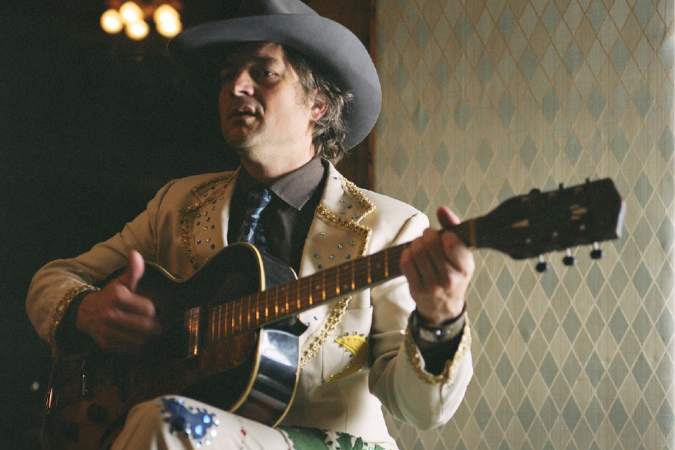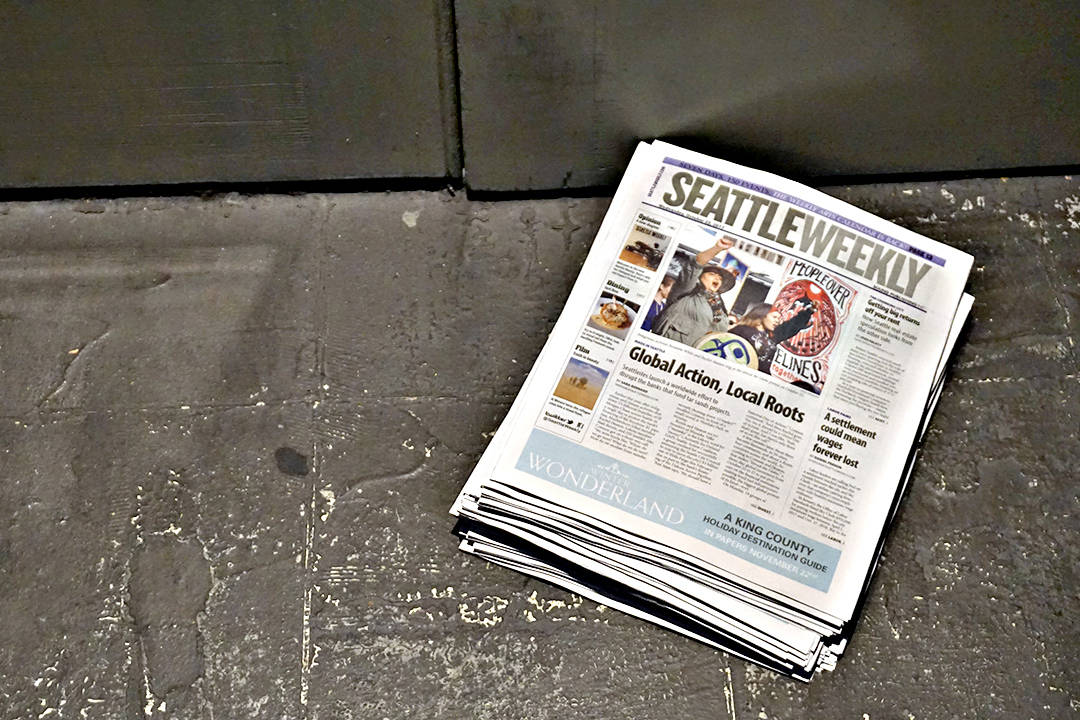Karl Blau usually does everything himself. So it is at first jarring to hear him singing radio-ready country songs written by other songwriters, his distinctive baritone backed by a full band, as on his latest full-length, Introducing Karl Blau.
But while it is Blau’s name that adorns the album with the winking title, this release is not a product of the Anacortes artist’s own prodigious creative streak. Rather, Blau was drafted for this project by Portland producer Tucker Martine, who asked him to lend his voice to a mix of well-worn hits, most of which were written in Nashville in the ’60s and ’70s.
The results are startling in their beauty, the singer’s voice a deep pool of emotion that scoops and croons as lush production—complete with swelling strings and backup singers—accompanies it, a far cry from the lo-fi four-track recordings that fill Blau’s voluminous catalog.
“If you know anything about my music, you know that it’s usually me playing all the instruments and producing it too,” Blau says over the phone from his Anacortes home. “So to let go completely was just really exciting and odd and strange for me.”
It also appears to have been a great career move. Even a full month before the album’s May 13 release, Blau had already received more attention for Introducing Karl Blau than for any other album to date. He has booked multiple full-band tours in Europe, where Bella Union will also release the album later this week, in addition to an extended U.S. tour schedule that will push well into the fall. He has been featured on NPR program World Café, and is seeing the album added to station playlists across the nation. Each morning he wakes up to e-mails from press and radio in Europe, where advance praise for the album has been particularly fervent. The appeal is the music, but Blau says Europeans also love the story being pitched with the album: that of a musician who has released more than 40 albums but is only now receiving a proper introduction.
Over the past two decades, Blau has recorded songs as many of us might keep a journal or update a Facebook status. Music has long been a means of self-exploration for him, a snapshot of a moment in the artist’s life, recorded in thrifty fashion, often in a single take, less for the sake of posterity than in the interest of process. The results have been predictably uneven, with some of his tortured folk experimentations verging on unlistenable. And yet within each of his wildly imaginative albums—seven of which have seen proper release on Northwest indies K, Knw-Yr-Own, and Marriage records—are moments of musical genius, searching pop songs marked by earworm melodies and that full, empathic voice.
That genius is what Martine heard when he first listened to Blau’s music near the turn of the millennium. It was back then that a young Laura Veirs was working on her debut album with the burgeoning producer at his studio, then located in Georgetown. Veirs played Blau’s 1997 album Shell Collection for Martine, and he heard something special. A couple of years later, when they were working on her third full-length, Martine made a request.
“We needed a wild card, so I asked Laura to phone up her friend Karl,” says Martine, who invited Blau to lend his multi-instrumental talents, and that voice, to what would become Veirs’ breakout album, Carbon Glacier. “Karl stayed a member of her musical family ever since. If I had my way, I would rope Karl into just about every record I work on.”
Blau was invited back to help record Veirs’ next album at Martine’s Flora Studio, which had by then moved, along with the producer, down to Portland. It was there that the seed for Introducing Karl Blau was planted. The tracking for Veirs’ album had finished, but neither Blau nor Martine was ready to be done. Martine cued up a recording that he had recently made with his own band, Mount Analog.
It was an instrumental for the Tom T. Hall song “That’s How I Got to Memphis,” an aching ballad that climbed the country charts when Bobby Bare released a version in 1970. Martine asked if Blau would add some bass and slide guitar to the record. Then someone, neither remembers who, suggested that Blau take a crack at the vocal.
Blau spent a day studying Hall’s original 1968 version of the song and laid down the track. On playback, he heard a version of himself he had never heard before. “It was so fun to hear my voice recorded in that way,” Blau recalls of his studio time with Martine. “He is just raising the bar whenever he records anything; he’s going for this really high mark.”
Bobby Bare’s take on “Memphis” was barely a memory when Tucker Martine was born to Linda and Layng Martine, Jr. in January 1972. Layng, like Hall, was a Nashville songwriter and had just had his own taste of chart success the year before, with his own recording of his song “Rub It In” reaching #65 on the Billboard Hot 100 chart. It was the beginning of a successful crossover career for Layng, who would go on to pen hits for Jerry Lee Lewis, Reba McEntire, the Pointer Sisters, and Elvis, eventually landing a spot in the Nashville Songwriters Hall of Fame.
Tucker remembers his father writing songs in the family’s kitchen and then, later, playing records by other artists singing those songs on the home stereo. Songwriting so pervaded the Martine household that young Tucker once believed his father wrote all the songs. Every one.
This fact came to a head after he heard his dad playing Barry Manilow’s 1975 recording of the Bruce Johnston-penned hit “I Write the Songs” on the stereo one day. “I told someone at school that he had written it,” Martine recalls now, on the phone from Portland. Eventually a classmate clued young Martine in on the truth, though it was only after his father confirmed this that Tucker understood. “And I’m going, ‘Shit, what else did you not write?’ ”
As he grew older, Martine would become more savvy about the world his father inhabited, finding a place for himself in it, though away from the Nashville scene. In 1993 he followed the mass musical migration to Seattle, where he began his career, starting as a drummer before becoming a producer with an impressive portfolio that has grown to include albums by the Decemberists, Jesse Sykes, Mudhoney, Bill Frisell, My Morning Jacket, and Neko Case, among others.
While his production work has been decidedly indie and his own band, Mount Analog, was largely experimental, Martine never entirely abandoned his Nashville roots. “Memphis,” in particular, stuck with him. “I had been obsessed with that song,” says Martine. “I would often play it at rehearsals while we were getting set up.”
He played it enough that eventually every member of the band could play along. While in Portland recording at Adam Selzer’s Type Foundry studio, Martine suggested that they record the instrumental, just for fun, thinking that the recording would just collect dust.
Then Blau walked into Martine’s studio and recorded that vocal track. Though he had only studied the song for one day, Martine recalls him nailing it on the first take. Suddenly, and unexpectedly, the song was finished.
The recording wasn’t experimental enough for a Mount Analog release, and it didn’t fit stylistically with any of the numerous albums Blau was working on at the time. But the management at K Records, which had just released its first Blau album, Beneath Waves, loved the recording and offered to release it as a 7-inch single. The song, an earnest, piano-forward recreation imbued with an invigorating sadness by Blau’s tender recitation, was a very different sound for Blau, but one his fans adored.
“Almost every show it would be what people wanted to hear,” Blau says. “When people would talk about my recordings, it would be at the top of their list.”
As Blau was hearing from fans, Martine was being nagged by his conscience, which was telling him that “Memphis” was only the beginning. “It was eating at me that that was the kind of thing that was important for me to do some day,” he says. “I really meant it.”
So it was two years ago, during a down period in Martine’s normally booked schedule, that the producer contacted Blau and asked if he would be interested in expanding on the “Memphis” session. Martine had a vision of recreating the process, having a hand-picked band record the instrumental tracks, then inviting Blau to step in and deliver the vocal. It was an approach very much like the one he witnessed in the Nashville studios of his youth, but not one very familiar to the artists who populated Martine’s world.
“That’s not the model that is attractive to me or any of the people I work with as a constant,” Martine says. “But as a variation it’s liberating in a way, I think, for Karl to just be the guy who’s gonna come in and sing his ass off and really get inside a song and bring it to life.”
Martine’s timing was perfect, says Blau. “My voice has unfolded so slowly over the past 20 years. It’s just like self-discovery, and more recently it’s more and more the place that I feel the most comfortable with. It’s the main thing that I have to offer.”
Soon Martine was digging into his record collection, spending six months revisiting the songs of his childhood and seeking numbers that shared a certain vibe with “That’s How I Got to Memphis.” “I’ve always felt that producing records for me, on the best day, I’m just being a music fanatic,” Martine says. “And I felt like that was the ultimate manifestation of that; I’m staying up late at night after my kids have gone to bed and I am pulling stacks of records off the bins, looking for songs, and it’s more than just because they are fun to listen to—I get to think about one of my favorite singers singing them.”
Martine would send songs he was considering to Blau, and Blau would send back demos recorded on his phone. “They all sounded nice, but occasionally one would just sound really special,” Martine says. “And that pretty much informed what the final song choice was.”
As he cobbled together the track list, Martine’s search strayed outside the original parameters to include works by rock legend Link Wray and folk songwriter Tom Rush, as well as the Bee Gees’ 1967 hit “To Love Somebody,” but for the most part the producer stayed true to his Nashville roots. The final album includes the original recording of “That’s How I Got to Memphis,” as well as songs written by Townes Van Zandt, Allen Reynolds, Bobby Bond, and Gary Paxton.
Despite the myriad distinctive songwriters whose work ultimately made up the album, Blau, the paragon of do-it-yourself indie, says he has found a way to make it his own. “I have this whole lore about it in my own head to get into it,” he says as he prepares for a summer of extensive touring, singing these songs written a generation ago. “There is this thread running through it that I really feel a connection with. I really relate to this character in these songs, shrouded in trials and tribulations, but there is this overwhelming feeling that you can get through this and transcend, that it is heading to this place that is more tranquil and more positive.”
That attitude is perhaps best captured on “Let the World Go By,” a melancholy meditation on resignation written by Martine’s father. The suggestion to include that song, the first of his father’s works that Martine has ever recorded, came directly from the songwriter himself.
“When Tucker first played me Karl’s record of ‘That’s How I Got to Memphis,’ I stopped in my tracks and said ‘I would pay to have that guy sing one of my songs,’ ” the elder Martine wrote Seattle Weekly in an e-mail. “It never came to that because Karl recorded one of my songs on this album and gave me one of the biggest thrills of my life.” Karl Blau album release show. The Vera Project, 305 Harrison St., 956-8372, theveraproject.org, 7:30 p.m., $8 adv., all ages. Sat., May 14.








